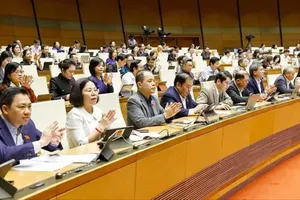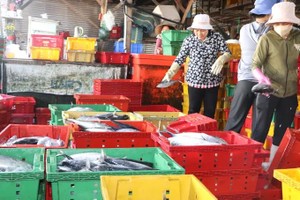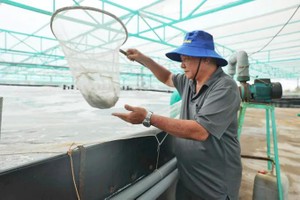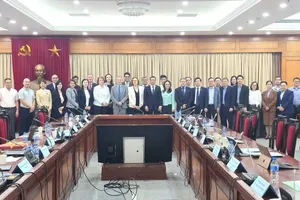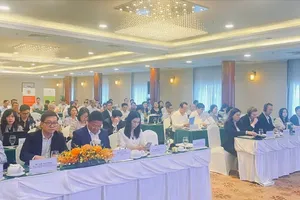 Non-fired building bricks are used at a construction work. (Photo: SGGP)
Non-fired building bricks are used at a construction work. (Photo: SGGP)
Consumption decreased
According to Assoc. Prof. - Dr. Le Trung Thanh, Director of the Institute of Building Materials under the Ministry of Construction, after more than ten years of implementing Decision No.567/QD-TTg of the PM, the investment, production, and use of non-fired building material in Vietnam has seen positive changes. The market has a wide range of non-fired products, such as block bricks, autoclaved cellular concrete, autoclaved lightweight concrete, precast lightweight concrete hollow core panels, and autoclaved aerated concrete panels.
However, the number of non-fired building material manufacturing facilities shows signs of decreasing. Currently, the country has about 1,600 active non-fired building material facilities, with a total design capacity of about 10.2 billion items per year. Meanwhile, in 2019, it had more than 2,000 facilities, with a total design capacity of about 12.6 billion items. "Non-fired building material manufacturing facilities are at risk of shrinking further if there are no mechanisms and policies to strongly promote the production and consumption of non-fired construction materials," said Assoc. Prof. - Dr. Le Trung Thanh.
According to the feedback of non-fired building material enterprises, the consumption of this type of building material faces many difficulties, with a relatively high inventory, so factories only dare to run below 50 percent of capacity. A representative of Thanh Hoa Province's Department of Construction said that 49 non-fired brick facilities in the province have a design capacity of more than 1 million items per year. However, the output is from 25 percent to less than 40 percent of design capacity. Especially, the production and consumption of non-fired materials in the past two years have decreased continuously by 5-6 percent per year. According to a representative of Hai Duong Province's Department of Construction, three out of five enterprises producing non-fired building materials in the province had to cease production due to difficulties in consumption. The situation is similar in many localities, such as Khanh Hoa, Binh Phuoc, Cao Bang, and Thai Nguyen.
There are many reasons why non-fired building material tends to decrease output. According to experts, the first reason is that most people still do not have the habit of using non-fired building materials. This product is not economically competitive with other types of baked materials. On the other hand, product quality is not ensured because production facilities are small in many localities, and it is difficult for authorities to control. In fact, the technology of many small and medium-sized facilities is only at an average level, producing low-quality products, leading to the situation that concrete bricks that are not old enough are put into the construction, causing shrinkage and cracking.
Another big difficulty that makes non-fired building materials unable to develop is that the system of standards, regulations, economic, and technical norms for this type of building material remains incomplete. A representative of the Vietnam Association of Building Materials said that, currently, product standards, building codes, architectural structures, and construction unit prices of all types of non-fired construction materials have not been promulgated synchronously and fully by the management agencies. Therefore, architects and construction engineers have difficulties in designating and estimating the volume of materials for the work. Not to mention that many new materials have not been issued with synchronous construction and acceptance instructions, causing confusion and inconvenience for construction units.
Standards need to be completed
According to Mr. Pham Van Bac, Director of the Department of Building Materials under the Ministry of Construction, over the past time, the Ministry of Construction submitted to the Government to issue documents promoting the development of new building materials, such as Decree No.09/ND-CP on the management of construction materials and Directive No.08/CT-TTg on promoting the use of ash, slag, and gypsum. Especially, recently, the Ministry of Construction has carried out many activities to research and produce new materials, aiming to promote the utilization of industrial waste, contributing to lower product costs. Notable products are bricks made from red mud and thermal fly ash and concrete from wastes of fertilizer factories. Initially, these products show technical and economic efficiency and are promising to be applied widely.
Mr. Pham Van Bac also said that in the coming time, the Ministry of Construction would complete standards, regulations, economic and technical norms related to non-fired building materials; continue to review, amend and supplement standards and regulations on the quality of non-fired products in the direction of improving quality requirements. At the same time, the Ministry of Construction will review, develop, and issue instructions for the construction and acceptance of non-fired building materials; strengthen the inspection and check on the quality of non-fired materials at production facilities and construction works using non-fired materials across the country. The Ministry of Construction also recommends localities strengthen control of the rate of using non-fired building materials in the process of appraising and approving construction investment projects following their competence and implement mechanisms and policies to support non-fired building materials enterprises in the area. In 2023, the Ministry of Construction is expected to continue to advise the PM to promulgate a national program to increase using wastes as raw materials and fuels in the production of building materials and construction works.
From the perspective of manufacturers, many people said that localities need to continue to thoroughly implement the Government's policy on gradually reducing the use of traditional baked clay bricks to develop non-fired building materials. In addition, there should be policies on tax on natural resources and environmental protection on these materials. At the same time, the management agencies need to have appropriate policies and incentives for the production, exploitation, and use of non-fired materials. Especially, enterprises need capital support to ensure the production capacity of high-quality products that can participate in large construction works and projects.
Some people also said that the PM's Decision No.2171/QD-TTg approving the program to develop the non-fired materials in Vietnam to 2030 would be a strong driving force to promote the consumption of non-fired materials in the coming time. In this decision, the PM has made specific requirements on the rate of non-fired materials in construction works and projects in each period. However, to strictly implement the Government's direction, the management agencies need to have strong enough sanctions for the use of non-fired materials that does not meet the rate and quality in construction works.
According to Assoc. Prof. - Dr. Le Trung Thanh, Director of the Institute of Building Materials under the Ministry of Construction, after more than ten years of implementing Decision No.567/QD-TTg of the PM, the investment, production, and use of non-fired building material in Vietnam has seen positive changes. The market has a wide range of non-fired products, such as block bricks, autoclaved cellular concrete, autoclaved lightweight concrete, precast lightweight concrete hollow core panels, and autoclaved aerated concrete panels.
However, the number of non-fired building material manufacturing facilities shows signs of decreasing. Currently, the country has about 1,600 active non-fired building material facilities, with a total design capacity of about 10.2 billion items per year. Meanwhile, in 2019, it had more than 2,000 facilities, with a total design capacity of about 12.6 billion items. "Non-fired building material manufacturing facilities are at risk of shrinking further if there are no mechanisms and policies to strongly promote the production and consumption of non-fired construction materials," said Assoc. Prof. - Dr. Le Trung Thanh.
According to the feedback of non-fired building material enterprises, the consumption of this type of building material faces many difficulties, with a relatively high inventory, so factories only dare to run below 50 percent of capacity. A representative of Thanh Hoa Province's Department of Construction said that 49 non-fired brick facilities in the province have a design capacity of more than 1 million items per year. However, the output is from 25 percent to less than 40 percent of design capacity. Especially, the production and consumption of non-fired materials in the past two years have decreased continuously by 5-6 percent per year. According to a representative of Hai Duong Province's Department of Construction, three out of five enterprises producing non-fired building materials in the province had to cease production due to difficulties in consumption. The situation is similar in many localities, such as Khanh Hoa, Binh Phuoc, Cao Bang, and Thai Nguyen.
There are many reasons why non-fired building material tends to decrease output. According to experts, the first reason is that most people still do not have the habit of using non-fired building materials. This product is not economically competitive with other types of baked materials. On the other hand, product quality is not ensured because production facilities are small in many localities, and it is difficult for authorities to control. In fact, the technology of many small and medium-sized facilities is only at an average level, producing low-quality products, leading to the situation that concrete bricks that are not old enough are put into the construction, causing shrinkage and cracking.
Another big difficulty that makes non-fired building materials unable to develop is that the system of standards, regulations, economic, and technical norms for this type of building material remains incomplete. A representative of the Vietnam Association of Building Materials said that, currently, product standards, building codes, architectural structures, and construction unit prices of all types of non-fired construction materials have not been promulgated synchronously and fully by the management agencies. Therefore, architects and construction engineers have difficulties in designating and estimating the volume of materials for the work. Not to mention that many new materials have not been issued with synchronous construction and acceptance instructions, causing confusion and inconvenience for construction units.
Standards need to be completed
According to Mr. Pham Van Bac, Director of the Department of Building Materials under the Ministry of Construction, over the past time, the Ministry of Construction submitted to the Government to issue documents promoting the development of new building materials, such as Decree No.09/ND-CP on the management of construction materials and Directive No.08/CT-TTg on promoting the use of ash, slag, and gypsum. Especially, recently, the Ministry of Construction has carried out many activities to research and produce new materials, aiming to promote the utilization of industrial waste, contributing to lower product costs. Notable products are bricks made from red mud and thermal fly ash and concrete from wastes of fertilizer factories. Initially, these products show technical and economic efficiency and are promising to be applied widely.
Mr. Pham Van Bac also said that in the coming time, the Ministry of Construction would complete standards, regulations, economic and technical norms related to non-fired building materials; continue to review, amend and supplement standards and regulations on the quality of non-fired products in the direction of improving quality requirements. At the same time, the Ministry of Construction will review, develop, and issue instructions for the construction and acceptance of non-fired building materials; strengthen the inspection and check on the quality of non-fired materials at production facilities and construction works using non-fired materials across the country. The Ministry of Construction also recommends localities strengthen control of the rate of using non-fired building materials in the process of appraising and approving construction investment projects following their competence and implement mechanisms and policies to support non-fired building materials enterprises in the area. In 2023, the Ministry of Construction is expected to continue to advise the PM to promulgate a national program to increase using wastes as raw materials and fuels in the production of building materials and construction works.
From the perspective of manufacturers, many people said that localities need to continue to thoroughly implement the Government's policy on gradually reducing the use of traditional baked clay bricks to develop non-fired building materials. In addition, there should be policies on tax on natural resources and environmental protection on these materials. At the same time, the management agencies need to have appropriate policies and incentives for the production, exploitation, and use of non-fired materials. Especially, enterprises need capital support to ensure the production capacity of high-quality products that can participate in large construction works and projects.
Some people also said that the PM's Decision No.2171/QD-TTg approving the program to develop the non-fired materials in Vietnam to 2030 would be a strong driving force to promote the consumption of non-fired materials in the coming time. In this decision, the PM has made specific requirements on the rate of non-fired materials in construction works and projects in each period. However, to strictly implement the Government's direction, the management agencies need to have strong enough sanctions for the use of non-fired materials that does not meet the rate and quality in construction works.
According to the Program on the development of non-fired materials in Vietnam, by 2025, the rate of non-fired materials must be at least 90 percent for construction works invested by public investment capital and non-State-budget public investment capital in Hanoi and HCMC; at least 70 percent in the remaining provinces and Grade-3 urban areas or higher, except for Da Nang and Can Tho cities, which must use at least 80 percent; at least 50 percent in the remaining areas. Construction works of nine floors or more must use at least 80 percent of non-fired materials compared to the total volume of construction materials, with priority given to the use of light and large-sized components.

